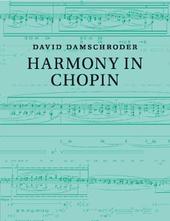
|
Harmony in Chopin
Paperback / softback
Main Details
| Title |
Harmony in Chopin
|
| Authors and Contributors |
By (author) David Damschroder
|
| Physical Properties |
| Format:Paperback / softback | | Pages:312 | | Dimensions(mm): Height 248,Width 190 |
|
| Category/Genre | Classical music (c 1750 to c 1830)
Bands, groups and musicians
Keyboard instruments |
|---|
| ISBN/Barcode |
9781107519565
|
| Classifications | Dewey:781.25168092 |
|---|
| Audience | | Professional & Vocational | |
|---|
| Illustrations |
121 Printed music items; 121 Tables, black and white; 121 Plates, black and white
|
|
Publishing Details |
| Publisher |
Cambridge University Press
|
| Imprint |
Cambridge University Press
|
| Publication Date |
24 January 2019 |
| Publication Country |
United Kingdom
|
Description
Chopin's oeuvre holds a secure place in the repertoire, beloved by audiences, performers, and aesthetes. In Harmony in Chopin, David Damschroder offers a new way to examine and understand Chopin's compositional style, integrating Schenkerian structural analyses with an innovative perspective on harmony and further developing ideas and methods put forward in his earlier books Thinking about Harmony (Cambridge, 2008), Harmony in Schubert (Cambridge, 2010), and Harmony in Haydn and Mozart (Cambridge, 2012). Reinvigorating and enhancing some of the central components of analytical practice, this study explores notions such as assertion, chordal evolution (surge), collision, dominant emulation, unfurling, and wobble through analyses of all forty-three Mazurkas Chopin published during his lifetime. Damschroder also integrates analyses of eight major works by Chopin with detailed commentary on the contrasting perspectives of other prominent Chopin analysts. This provocative and richly detailed book will help transform readers' own analytical approaches.
Author Biography
David Damschroder is Professor of Music Theory at the University of Minnesota. His current research focuses on harmony in tonal music, a project that began with a careful examination of historical analytical practices and was the basis for his book Thinking about Harmony: Historical Perspectives on Analysis (Cambridge, 2008). The project continues with focused studies on selected repertoires: Harmony in Schubert (Cambridge, 2010), Harmony in Haydn and Mozart (Cambridge, 2012), and the present book. In addition, he is currently writing a textbook on Schenkerian analysis. He has written textbooks on music fundamentals and ear-training and sight-singing, and his articles and reviews have appeared in numerous journals.
|